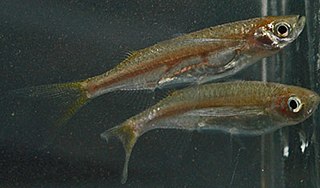| Wikispecies has information related to Parachela . |
Parachela may refer to:
- Parachela (fish), a genus of fishes in the family Cyprinidae
- Parachela (tardigrade), an order of tardigrades in the class Eutardigrada
| Wikispecies has information related to Parachela . |
Parachela may refer to:

Eutardigrada are a class of tardigrades (Tardigrada) without lateral appendices. Primarily freshwater bound, some species have secondarily gained the ability to live in marine environments (Halobiotus). By cryptobiosis many species are able to live temporarily in very dry environments. More than 700 species have been described.

Periphyton is a complex mixture of algae, cyanobacteria, heterotrophic microbes, and detritus that is attached to submerged surfaces in most aquatic ecosystems. The related term Aufwuchs refers to the collection of small animals and plants that adhere to open surfaces in aquatic environments, such as parts of rooted plants.

Parachela is a genus of cyprinid fishes. There are currently seven species in this genus which are found in Southeast Asia.

A eurytherm is an organism, often an endotherm, that can function at a wide range of ambient temperatures. To be considered a eurytherm, all stages of an organism's life cycle must be considered, including juvenile and larval stages. These wide ranges of tolerable temperatures are directly derived from the tolerance of a given eurythermal organism's proteins. Extreme examples of eurytherms include Tardigrades (Tardigrada), the desert pupfish, and green crabs, however, nearly all mammals, including humans, are considered eurytherms. Eurythermy can be an evolutionary advantage: adaptations to cold temperatures, called cold-eurythemy, are seen as essential for the survival of species during ice ages. In addition, the ability to survive in a wide range of temperatures increases a species' ability to inhabit other areas, an advantage for natural selection.

Tardigrades, known colloquially as water bears or moss piglets, are a phylum of eight-legged segmented micro-animals. They were first described by the German zoologist Johann August Ephraim Goeze in 1773, who called them Kleiner Wasserbär. In 1777, the Italian biologist Lazzaro Spallanzani named them Tardigrada, which means "slow steppers".

Parachela is an order of tardigrades in the class Eutardigrada. They have existed for at least 72 million years and they still exist today. The oldest member of Parachela is Beorn.

Tactopoda is a proposed clade of protostome animals that includes the phyla Tardigrada and Euarthropoda, supported by various morphological observations. The cladogram below shows the relationships implied by this hypothesis.
Parachela maculicauda is a freshwater fish in the genus Parachela, family Cyprinidae and order Cypriniformes. It occurs in lowland rivers and swamps in small groups. Found at the water surface in small and medium-sized rivers with nearby areas of floodplain forest. Feeds on plankton. It is found in the basins of the Mekong River and Chao Praya as well as the Malay Peninsula and on the island of Sumatra and in Sarawak, it has also been possibly recorded from the Mae Klong It is a small fish growing to a maximum length of 6 cm and is characterised by two blotches near the tips of each lobe of the caudal fin. It is of limited interest in fisheries but is used to make prahok. It is also of little interest to the aquarium trade.

Parachela oxygastroides, also known as the glass fish, is a freshwater fish of the family Cyprinidae. It is found in Southeast Asia in rivers and wetlands, including seasonally flooded forests. Of length 10–20 cm, it is caught commercially for food and sold in markets; it is one of the species used in Cambodian cuisine to make the fish paste prahok.
Parachela siamensis is a small species of freshwater ray-finned fish in the carp and minnow family Cyprinidae.
Ojo del Sol, also called The Fish House by local residents, is a home designed in 1993 by architect Eugene Tssui. The building was constructed between 1994 and 1995 in a residential neighborhood of Berkeley California. The home's name "Ojo Del Sol", Spanish for "Eye of the Sun", originates from the fifteen foot diameter eye-like window that faces south. According to the architect, the structure is based upon the world's most indestructible living creature, the tardigrade.
Parachela cyanea is a species of cyprinid in the genus Parachela. It inhabits Indonesian Borneo and has a maximum length of 4.9 centimetres (1.9 in). It is considered harmless to humans.
Parachela hypophthalmus is a species of cyprinid in the genus Parachela. It inhabits Thailand, Malaysia and Indonesia, in Sumatra and Borneo and has a maximum length of 16.5 centimetres (6.5 in). It has been assessed as least concern by the IUCN, and is considered harmless to humans.
Parachela ingerkongi is a species of cyprinid in the genus Parachela. It inhabits Borneo and is considered harmless to humans.
Parachela williaminae is a species of cyprinid in the genus Parachela. It inhabits Thailand, Cambodia and Laos. It has a maximum length of 12 centimetres (4.7 in) and is used for food locally. It has been assessed as "least concern" on the IUCN Red List and is considered harmless to humans.
Tardigrade specific proteins (TDPs) are specific types of Intrinsically Disordered Proteins (IDPs) that are seen in tardigrades. They are most notably used to help them survive desiccation which makes them very extremotolerant.
Calohypsibiidae is a family of tardigrades belonging to the order Parachela.
Richtersiidae is a family of tardigrades belonging to the order Parachela.

Paradoryphoribius is an extinct genus of tardigrades from the order Parachela. It is the third fossil tardigrade to be named, described in 2021 from Miocene Dominican amber from the Dominican Republic. The type, and currently only species, is P. chronocaribbeus. Paradoryphoribius is the first extinct tardigrade known from the Cenozoic and is also the first tardigrade known from the Miocene. It has a length of 539 microns.